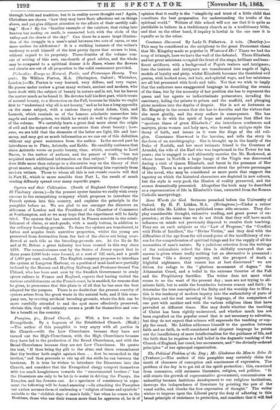Constance Sherwood. By Lady G. Fullerton. 8 vols. (Bentley.)_ This
may be considered as the antiphony to the great Protestant chant that Mr. Kingsley made so popular in Westward Ho ! There we had the song of triumph, here we have the wail of the defeated. There Flivabeth and her great ministers occupied the front of the stage, brilliant and bene- ficent artificers, with a background of Popish traitors and intriguers; here the traitors and intriguers are transformed into angels of light, models of loyalty and piety, whilst Elizabeth becomes the theatrical evil genius, with hooked nose, red hair, and spiteful ways, and her ministers are all but presented with hoofs and tails. Not that we wish to imply that the authoress uses exaggerated language in describing the events of the time, but by the necessity of her position she has to represent the queen and her agents as indiscriminate persecutors, invading the sanctuary, haling the priests to prison and the scaffold, and plunging pions maidens into the depths of despair. She is not so fortunate as Mr. Kingsley in the scenes that she has to describe and the virtues that she must glorify, and the story suffers in consequence. She has nothing to do with the spirit of hope and enterprise that filled the "spacious times of great Elizabeth ;" she introduces confessors and martyrs, pious women and holy men, who bewail in antique style the decay of faith, and intone as it were the dirge of the old reli- gion. Constance Sherwood is the heroine, and tells the story in the form of an autobiography. She is brought up in the family of the Duke of Norfolk, and her most intimate friend is the Countess of Arundel, the wife of the Earl who was imprisoned in the Tower for ten_ years ; she is engaged to and ultimately marries the Mr. Rookwood, at whose house in Norfolk a large image of the Virgin was discovered during a visit of Queen Elizabeth, and burnt in the presence of Her Majesty. There is no particular interest about the private personages of the novel, who may be considered as mere posts that support the tapestry on which the historical characters are depicted in new colours, but the style is very good, the illusion of reality preserved, and the scenes dramatically presented. Altogether the book may be described as a representation of life in Flivabeth's time, extracted from the Roman Catholic martyrology.






























 Previous page
Previous page